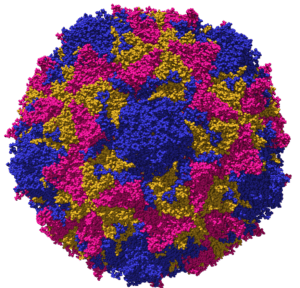

The study group consisted of 17 individuals who developed poliomyelitis in the pre-vaccine years, 1940-1950, and one who was paralyzed in the early 1970s. Bioinformatic analyses of whole-exome sequencing results identified 39 heterozygous missense mutations in 36 genes. None were shared between any of the patients. These polymorphisms were specific to poliomyelitis because they were not observed in a cohort of 18 patients with herpes simplex encephalitis.
Most of the mutations are in genes with either similar biological functions, or that are part of common signaling pathways. For example, variants in some genes are involved in autophagy or apoptosis. Both are antiviral processes and a reduction in them could lead to higher levels of poliovirus reproduction. Increased viremia could make it more likely that virus invades the brain and spinal cord.
Additional variants were identified in the genes encoding the innate immune system RNA sensors Mda5 and TLR3, and in the gene encoding the type I IFN receptor. Defects in the IFN pathway could also lead to higher viral replication and invasion of the CNS as suggested above.
To determine whether any of these mutations have an effect on poliovirus reproduction, infections were carried out with cultures of peripheral blood mononuclear cells and monocyte derived macrophages from the patients. Virus yields were generally higher in cells from poliomyelitis patients. However this difference could not be ascribed to mutations in any specific genes. Furthermore, there appeared to be no defect in IFN responses after viral infection.
It is formally possible that small numbers of polioviruses enter the brain and spinal cord during most infections, but do not proceed to paralysis. In individuals with specific mutations identified in this study, reproduction in neurons might be facilitated. The authors did not address this possibility by examining the effect of these genetic changes on replication in neural cells.
This study is the first to reveal potential genetic susceptibility loci in patients with paralytic poliomyelitis. The identified mutations should be introduced in cell types known to be relevant to infection, such as intestinal epithelial cells and neurons, to determine their effect on viral yields. The effect of such mutations in a mouse model for poliomyelitis should also be determined. Furthermore, susceptibility loci should be identified in patients who developed vaccine-associated polio (VAPP). The latter are even more rare (1 in 1.5 million recipients of oral poliovirus vaccine). Such an analysis could reinforce the observations made in the study discussed above, or identify variants in different genes that predispose vaccine recipients to VAPP.
